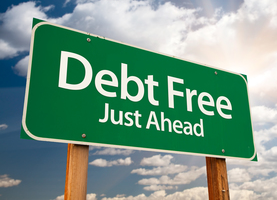by Tricia
Today I have a guest post from Debbie Dragon. She’s a writer for DestroyDebt.com, a website dedicated to helping people find their way out of debt and into a more rewarding, financially secure future. The website also runs one of the forums that I mentioned in the list of debt forums that I have found.
Most people make New Year’s resolutions, and the majority of people probably include “lose weight” as one of their top resolution goals. But what about your finances? Isn’t the New Year a good time to resolve to make yourself more financially-fit, as well?
If you’ve got credit cards, loans, and other sources of debt, it can often leave you feeling discouraged and wondering how you could ever pay it all off. Becoming debt-free is a possibility, and there is no time like the present to make it happen. Here’s what you can do to get started to a financially-fit you in 2008:
Know What You Earn
I’m not talking about what you earn on paper for your annual salary; I’m talking about the amount you actually see in your paycheck after your deductions are taken out. How much do you make each month after you’ve paid your health insurance, work loans, taxes and whatever else is taken from your pay before you even see it?
Know What You Owe
Take an hour or two and make yourself a detailed list. Write down everything you pay each month, the minimum payment due, the date it’s due, how much you owe to be free and clear of that debt, and what the interest rate is. For expenses you don’t pay monthly, estimate the amount you do pay (quarterly or annually) and then break it down into a monthly amount. For example, if you average about $1200 a year on car maintenance and repairs, include $100 per month for this expense.
Once you have your list of everything you owe, look at it again. Did you forget to include your gasoline? Did you include your daily coffee at Starbucks or the newspaper you grab on your way to work? If these are things you pay for more often than not, you must include them as your living expenses (unless you are going to change your habits and stop buying these non-essentials immediately- which is a good idea if you’re looking to get out of debt!)
Create Your Debt Repayment Plan
Going someplace you’ve never been is difficult without a map or directions of some sort; getting to a debt-free status is just as difficult without a real plan. Your debt repayment plan is your roadmap out of debt and into a financially-fit lifestyle.
Determine what areas of your “what you owe” list can be eliminated or reduced. Do you really need to pay $102 a month for cable tv, just so you can have high definition or 234 channels? Can you make coffee at home and skip the daily stop at your local coffee shop, and bring your lunch from home instead of getting fast food? These are all areas that seem like such an insignificant amount when you’re buying it; but over a year’s time the amounts add up and could go a long way to getting you out of debt if you eliminated and reduced these non-essentials.
Once you’ve narrowed your list down to the essential expenses, decide how much you can comfortably afford to pay off on each account, each month. The Snowball Method is highly recommended, as each time you pay off an account you will have that much more money to apply to the next account on the list, and as your payments snowball bigger, the amount of debt you owe is decreasing. Another method many financial advisors will recommend is paying off accounts with higher interest first.
Regardless of your method of choice, it’s important that you create a plan on PAPER, and hold yourself accountable. Just as a weight loss resolution requires determination, motivation, and discipline- the resolution to become more financially-fit requires the same.
Thanks, Debbie for the guest article! 🙂





So, what do you think ?